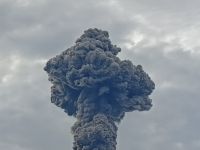Hurricane Michelle, the most powerful storm to barrel toward Cuba in the past half-century, was set to make landfall on the island early Sunday, prompting authorities to evacuate 150,000 people from the crowded capital of Havana.
Forecasters from the National Hurricane Center (NHC) in Miami labeled the category four storm "extremely dangerous." Hurricane warnings extended across central and western Cuba, as some compared Michelle ominously to a November 9, 1932, storm that flattened the town of Santa Cruz del Sur and killed some 3,000 people.
"We are setting up for what appears to be a real disaster in Cuba," said Max Mayfield, director of the National Hurricane Center.
In addition to the Havana evacuation, Cuban officials cleared out luxury tourist resorts and ordered some 35,000 students to leave camps in the Zapata Peninsula near the Bay of Pigs.
"It's been 50 years since we've had a high-powered hurricane in Cuba, and the population should prepare itself for what's coming," Jose Rubiera, head of forecasting for Cuba's meteorological institute, said on national television.
Michelle chugged toward Cuba on a path that would make a direct hit on Havana, where building collapses after storms are major seasonal concerns among its more than two million residents.
At 0600 GMT, a hurricane warning was in effect for western Cuba from Pinar del Rio eastward to Ciego de Avila. The eye of the hurricane was located 325 kilometers (205 miles) south-southwest of Havana. Michelle ambled toward the north-northeast early Sunday at around 8 kilometer (5 miles) per hour, with maximum sustained winds measuring 215 kilometer (135 miles) per hour.
Rainfall totaling 25-50 centimeters (10-20 inches) was expected in the areas along the hurricane's path, the NHC said.
The storm already has dumped heavy rains that flooded rivers and triggered mudslides across much of Central America, leaving at least 10 people dead and thousands homeless.
Worried Havana residents lined up at the few stores open Saturday to stock up on food in intermittent rain and light winds. Residents spent much of the day taping their windows and putting up storm shutters.
The national information agency said food, water and medicine had been sent to communities south of the capital that could be cut off in the event of a major storm.
Cuban officials cancelled all national and international flights until Monday.
In the southern United States meanwhile, where the hurricane was forecast to make landfall on Monday, Florida Governor Jeb Bush declared a state of emergency and the lower Florida Keys were under an evacuation order.
A tropical storm warning was in effect for the southeastern and southwestern coasts of Florida, including the Florida Keys.
Officials in the southeastern US state were hoping for a last minute detour by the storm -- but were not counting on it.
"If it doesn't make that turn to the northeast and travels further to the north before it makes it, then we could be faced with a serious situation," said Billy Wagner, senior director of emergency management for the Keys. "We don't have the luxury to wait."
A tropical storm watch was in effect for parts of the Bahamas, the island of Grand Cayman, and certain areas of Mexico, including tourist hotspots like Cancun and Cozumel.
Honduras urgently sought aid after Michelle claimed six lives, left 14 others missing and forced more than 27,000 from their homes. In Nicaragua, four people were listed as dead, 12 others were missing and 10,000 were left homeless, while in Guatemala authorities declared an alert.
In Costa Rica, where a state of emergency was declared Friday, authorities said the rains stirred up by Michelle had caused about 10 million dollars in infrastructure damage, as well as extensive flooding in the north and along the Pacific coast.
The Atlantic hurricane season officially stretches from June through November. Late-season storms commonly form in the south-central to southwestern Caribbean and typically are slow-moving, giving them more time to gather force, dump heavy rains and trigger deadly floods.
Hurricane Mitch killed some 20,000 people and causing some 6.5 billion dollars in damage after striking Central America October 26, 1998 -- AFP
© 2001 Al Bawaba (www.albawaba.com)







